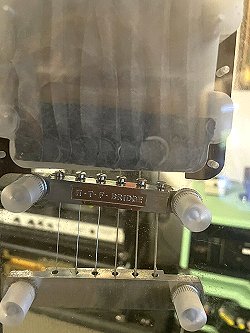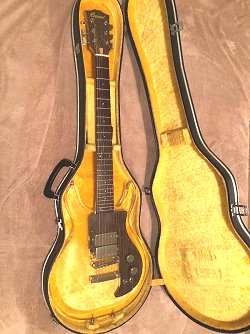
Conrad was another badge name copy of the Dan Armstrong guitar. Known as the
'Bumper' model, along with the model number of 40223 it's alot like other brands that came out of Japan. At left, notice a Gibson, or Gibson
style 'poker chip' trim ring ffor their selector switch stands in as a patch for a broken scratchplate around the output jack.
At left and right, the neck and headstock of this Conrad. Notice the original tuners. This is one of the cleanest copies I'vr seen.
As seen upper left, the Conrad guitar sports humbuckers instead of the blade version pickups. Another difference is the presence of a tuno-matic style
adjustable bridge, as well as a stop type tailpiece. Notice the all-chrome volume & tone knobs. Ironically, in 1973 - literature on these instruments
states that the guitar features "dual volume and tone controls" which would seem to suggest a typo &/or confusion with another one of their models. As
usual, a 3-way selector switch & output jack are mounted on the faux-wood scratchplate.
At right, and seen from the back, the bottom of the pickups show the adjustable pole pieces. Also seen, are the volume & tone pots as well as the wiring
within the control cavity. Notice the short routing to the stop tailpiece studs for the grounding wire.
I've often wondered whether the pickups on the Conrad guitars were actually humbuckers or single coil but Steve Vineis writes in to describe the pickups
on a Conrad copy that he once owned stating "The pickups were surely humbuckers as I recall them being heavy in weight and revolting in tone. Like if
you were to put your amp in the bathroom and close the door was how they sounded. They were medium output with no bite, and nothing single-coily about them.
I've heard what you've heard about Japanese factories basically cramming SCs in HB housings, and while I never cracked mine open to confirm, I can say with
some degree of certainty they were humbuckers." Given this vivid description I feel it's safe to say that the Conrad models were, in fact, equipped
with humbuckers and I would love to hear from others who own, or have owned Dan Armstrong copies equipped with humbuckers about this.
Another Conrad Dan Armstrong copy with some form of blistering on the faux-wood veneer of the headstock at upper left. Notice some sort of blemish by the
2nd string tuner post. Perhaps a cigarette burn (or something).
At right, a closer look at the tuners from the backside of the headstock. While the tuners housings look similar to those seen on other copies - the pegs
themselves take on a totally different look. Notice the 3-piece laminated maple neck with extra pieces added onto the headstock in the usual fashion.
At left, and again unlike prior copies, the Conrads fingerboard utilizes smaller dot position markers on the rosewood fingerboard which - according to
the Conrad literature, has a 247/8" scale length and features 24 frets. Notice that the output jack is reinforced by a washer in the usual
fashion.
At right, I always seem to cringe when I see how little of the neck is secured to the acrylic body on most of the Dan Armstrong copies. No doubt this is
due to the fact that most are equipped with two pickups. It makes little difference whether they're humbuckers or single-coil units - as even the latter
occupy the same physical space on these models, leaving less space for a longer neck tongue to reside in the acrylic body. As it is, and according to
literature, the overall length of the Conrad Bumper model is 391/4".
At upper left, a Conrad guitar with some different pickups installed. At right, the neck is unlike those seen on the Conrad models above.
At left and right, the same Conrad model as above but with a different backdrop.
At left and right, the Conrad model lies in its factory case which appears to have a scratchplate screw lying in it..
At left, the stock all-chrome volume & tone knobs seen on the Bumper guitars has been swapped out with knobs somewhat like those seen on other badged copies - in that
they feature wooden inserts on the top of the knobs. However, there are differences as these knobs are a bit smaller in diameter and sport smooth sides to them, whereas
the originals have knurled sides. The creme colored pickup is of unknown origin, while the black pickup looks like it could be a DiMarzio Deuce II or Super II but I
can't be sure.
At right, tooling marks can be seen in the pickup cavity. Unusual to these guitars the neck does not seem to have a shim under the tongue. Notice the pickguard mounting
screw lying in the case which usually doesn't play nice with plexiglass.
As seen left and right, this Conrad model has had its original tuners changed out to a set of Grover Rotomatics.
At left and right, a Conrad model in mint condition, looking like it just rolled off the assembly line.
Looking at these photos it appears that this bridge employs nylon saddle pieces.

|
Seen from the back side of this instrument, the bottom of the bridge is easily legible. Like many of the copy brands an
H · T · F· Bridge is employed.
Despite my efforts there is little, if anything that is known about this brand. One can only speculate that they were a major supplier of parts for the various factories.
|
On the left, the letter 'd' in the Conrad name is nearly gone, while at right, the Made In Japan sticker is still legible.
At left, a Conrad Bumper guitar that's had its front and rear pickups turned around so that their respective pole pieces are facing one another. Notice the rather large
blister in the veneer on the headstock. At right, it appears the original tuners may have been replaced by a set of Schallers, but it's hard to say for certain. However,
one thing that is certain is the 3-piece laminated neck showing yet again, a mahogany center laminate - telling us that the Conrad model shown above was not a 'one-off'.
As stated on Frank Meyers site - where he was talking about a Japanese guitar from the 60's - "Take for instance the Apollo
brand; we know from looking at one Apollo catalog from the 1960's that Apollo guitars were being made by Guyatone, Kawai, and Zenon, all within the same
year!!" Granted, that was the 60's but I believe that little had changed during the 70's 'copy-era' and when I discover instruments made
to literature only to then find instruments from the same line with totally different - and major parts - like necks - I have to wonder.
At upper left & right another Conrad copy, seen here minus the guitar strings. At left, notice also the lack of a truss rod cover - while at right,
and seen better in enlarged view - is breakage at the corners of the scratchplate on the 6th string side.
At left, the routed cavities of the acrylic body can be seen. I still appreciate the short channel that was routed for the ground wire when compared to
some other models. Unfortunately there is no bevelling done in the cutaway horns which can make getting to those last frets more difficult. At right,
another angle of the instrument showing the radius of a beautiful rosewood fingerboard. Also seen are the chrome plated knurled volume and tone control
knobs, which - as can be seen in enlarged view - are secured in place by set-screws.
At left & right - the return of an all maple neck with no dark woods making up one of the laminates. Apparently the earlier models had all maple necks while
later models featured a mahogany central laminate. This isn't a small change and one cannot help but wonder what transpired.
Upper left, another Conrad headstock with the usual, but at least smaller.... blemishes on the headstock. This model still sports its original tuners and are
the same type as those seen on many other copy models.
At right, another bridge that appears to house nylon saddlepieces instead of metal ones show on other Conrad guitars. Seen better in enlarged view, the last
screw in the scratchplate appears to be a replacement that is more flatter compared to the others.
At left, and according to Conrad literature, 'the steel reinforced slim-line neck features an ovalled rosewood fingerboard and 24 nickel silver
frets clear of the body'. The fingerboard features small dot mother-of-pearl position markers. At right the Bumper guitar can be seen inside
its factory hard-shell case.
At left, and seen better in the enlarged view, another Conrad guitar model that has a broken scratchplate in some unusual places with one being up by the neck
on the sixth string side and another around the rear pickup - again on the same side. For whatever reason(s) this type of breakage seems to be fairly common among
these guitars. At right and like the model before it, this one also has an all maple neck.
At left, a closer look at the broken scratchplate. Notice the original phillips screw still in the acrylic body by the rear pickup. At right, the Conrad name can
be seen on a clean looking headstock, a wild E-string notwithstanding.

|
The Conrad Bumper guitar rests in its factory case. The truss rod cover is off, perhaps an adjustment was made just prior to the photo.
According to the book 'Guitar Stories, Volume One' by Michael Wright, Conrad instruments were produced by Kasuga International (Kasuga & Tokai USA, Inc.).
They were made by Matsumoku and imported into the US by David Wexler & Co. of Chicago, IL.
|
copies menu
main menu
Names and images are TMand © Dan Armstrong / Ampeg. All rights reserved.
All other names and images are TMand © of their respective owners. All rights reserved.
|
| |

